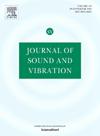基于矩阵法的拉伸机械超材料带隙设计
IF 4.9
2区 工程技术
Q1 ACOUSTICS
引用次数: 0
摘要
建立了拉伸主导机械超材料单元胞的矩阵动力学方程,并将其建模为销杆结构。通过引入Bloch定理压缩等效节点的自由度,将动力学方程转化为求解超材料色散函数的广义特征方程。通过对广义特征方程的分析,证明了带隙存在的必要条件是超材料的不等价节点数大于1。给出了计算不相等节点数的公式,表明一般可以通过插入节点或重新定义单元格来增加不相等节点数。基于矩阵摄动和梯度下降法,提出了一种通过优化单元胞的单元横截面积和节点坐标来生成具有期望宽度或范围的带隙的数值策略。利用矩阵摄动也可以消除色散函数的简并点。以两种超材料为例,验证了所提方法的有效性。规定的带隙是通过增加不等效节点的数量,优化元件的横截面积和节点坐标来产生的。本文章由计算机程序翻译,如有差异,请以英文原文为准。
A matrix method for designing bandgap of stretch-dominated mechanical metamaterials
The dynamic equation in matrix form is established for the unit cell of stretch-dominated mechanical metamaterials, which is modelled as a pin-bar structure. By condensing the degrees of freedom of equivalent nodes by introducing Bloch’s theorem, the dynamic equation is transformed into a generalized characteristic equation for solving the dispersion function of metamaterials. It is proven that the necessary condition for a bandgap to exist is that the number of inequivalent nodes of the metamaterial is greater than 1 by analysing the generalized characteristic equation. The formula for calculating the number of inequivalent nodes is given, which indicates that it can generally be increased either by inserting nodes or by redefining the unit cell. Based on matrix perturbations and the gradient descent method, a numerical strategy is proposed to generate a bandgap with an expected width or range by optimizing the element cross-sectional areas and node coordinates of the unit cell. The degenerate points of the dispersion function can also be eliminated by using matrix perturbations. Two metamaterials are employed as examples to verify the validity of the proposed method. The prescribed bandgaps are generated by increasing the number of inequivalent nodes and optimizing the element cross-sectional areas and node coordinates.
求助全文
通过发布文献求助,成功后即可免费获取论文全文。
去求助
来源期刊

Journal of Sound and Vibration
工程技术-工程:机械
CiteScore
9.10
自引率
10.60%
发文量
551
审稿时长
69 days
期刊介绍:
The Journal of Sound and Vibration (JSV) is an independent journal devoted to the prompt publication of original papers, both theoretical and experimental, that provide new information on any aspect of sound or vibration. There is an emphasis on fundamental work that has potential for practical application.
JSV was founded and operates on the premise that the subject of sound and vibration requires a journal that publishes papers of a high technical standard across the various subdisciplines, thus facilitating awareness of techniques and discoveries in one area that may be applicable in others.
 求助内容:
求助内容: 应助结果提醒方式:
应助结果提醒方式:


